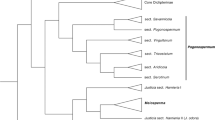Abstract
A new genus,Stanmarkia, is described from the volcanic highlands of western Guatemala and adjacent Chiapas, Mexico to includeS. medialis, comb. nov. andS. spectabilis, sp. nov. Among the Melastomataceae,Stanmarkia is distinguished by its 5-merous flowers, subequal stamens that lack prominently developed appendages or prolonged connectives, terete hypanthia, and clavate-cuneate seeds that have an enlarged excurrent arilloid raphe and a tuberculate seed coat. A gametic chromosome count ofn=40 is reported here forS. spectabilis. This count, which is clearly of polyploid origin, represents a new definitive number for the family. An emphasis on seed characters suggests placement ofStanmarkia in the Sonerileae which is here interpreted in a broad sense to include all genera previously assigned to the New World Bertolonieae and the Old World Oxysporeae. A consideration of other characters such as configuration of the ovary apex, capsule morphology, and androecial details also provides evidence for placement ofStanmarkia in the Merianieae.
Similar content being viewed by others
Literature Cited
Almeda, F. 1977. Systematics of the neotropical genusCentradenia (Melastomataceae). J. Arnold Arbor. 58: 73–108.
— 1989. Five new berry-fruited species of tropical American Melastomataceae. Proc. Calif. Acad. Sci. 46: 137–150.
— &T. I. Chuang. 1992. Chromosome numbers and their systematic significance in some Mexican Melastomataceae. Syst. Bot. 17: 583–593.
Bakhuizen Van Den Brink, Jr.,R. C. 1943. A contribution to the knowledge of the Melastomataceae occurring in the Malay Archipelago, especially in the Netherlands East Indies. Rec. Trav. Bot. Néerl. 40: 1–391.
Bradley, M. V. 1948. An aceto-carmine squash technic for mature embryo sacs. Stain Technol. 23: 29–40.
Breedlove, D. E. 1981. Introduction to the flora of Chiapas. Flora of Chiapas pt. 1: 1–35. California Academy of Sciences. San Francisco.
Briggs, B. G. &L. A. S. Johnson. 1979. Evolution in the Myrtaceae—evidence from inflorescence structure. Proc. Linn. Soc. New South Wales 102: 157–256.
Chuang, T. I., C. Y. Chao, W. W. L. Hu &S. C. Kwan. 1963. Chromosome numbers of the vascular plants of Taiwan. I. Taiwania 1: 51–66.
Cogniaux, C. A. 1891. Mélastomacées. Pages. 1–1256.In: A. & C. de Candolle. Monographiae phanerogamarum. Vol. 7.
Cogniaux, C. A. 1908. Melastomataceae peruvianae.In: I. Urban, editor. Plantae novae andinae imprimis Weberbauerianae IV. Bot. Jahrb. Syst. 42: 131–148.
Dengo, G. & O. Bohnenberger. 1969. Structural development of northern Central America. Pages 203–220.In: A. R. McBirney, editor. Tectonic relations of northern Central America and the western Caribbean —The Bonacca Expedition. Mem. Amer. Assoc. Petr. Geol. 11.
Don, D. 1823. An illustration of the natural family of plants called Melastomaceae. Mem. Wern. Nat. Hist. Soc. 4: 276–329.
Erdtman, G. 1971. Pollen morphology and plant taxonomy. Angiosperms. Hafner Publ. Co., New York.
Farron, C. &C. Favarger. 1983–84). Contribution à la cytotaxonomie des Mélastomatacées africaines. Garcia de Orta. Sér. Bot. Lisboa 6: 83–88.
Favarger, C. 1952. Recherches sur quelques Mélastomacées d'Afrique occidentale. Ber. Schweiz. Bot. Ges. 62: 5–65.
Favarger, C. 1962. Nouvelles recherches cytologiques sur les Mélastomatacées. Ber. Schweiz. Bot. Ges. 72: 290–305.
Gleason, H. A. 1931. Botanical results of the Tyler-Duida Expedition. Bull. Torrey Bot. Club 58: 405–464.
Hansen, C. 1990. New species and combinations inAllomorphia, Phyllagathis, andSporoxeia (Melastomataceae) in Indo-China. Bull. Mus Hist. Nat. (Paris) 4 Sér., 12, sect. B, Adansonia, no 1: 37–41.
Hickey, L. J. 1979. A revised classification of the architecture of dicotyledonous leaves. Pages 25–39.In: C. R. Metcalfe & L. Chalk. Anatomy of the dicotyledons, Vol. 1. Ed. 2, Clarendon Press. Oxford.
Hooker, J. D. 1867. Melastomaceae. Pages 725–773.In: G. Bentham & J. D. Hooker. Genera plantarum. Vol. 1.
Mehra, P. N. 1976. Cytology of Himalayan hardwoods. Sree Saraswaty Press, Calcutta, India.
O'Dowd, D. J. &M. F. Willson. 1989. Leaf domatia and mites on Australasian plants: ecological and evolutionary implications. Biol. J. Linn. Soc. 37: 191–236.
Patel, V. C., J. J. Skvarla &P. H. Raven. 1985. Pollen characters in relation to the delimitation of Myrtales. Ann. Missouri Bot. Gard. 71: 858–969.
Pemberton, R. W. &C. E. Turner. 1989. Occurrence of predatory and fungivorous mites in leaf domatia. Amer. J. Bot. 76: 105–112.
Raven, P. H. &D. I. Axelrod. 1974. Angiosperm biogeography and past continental movements. Ann. Missouri Bot. Gard. 61: 539–657.
Renner, S. S. 1990. A revision ofRhynchanthera (Melastomataceae). Nord. J. Bot. 9: 601–630.
Ruys, J. D. 1925. Reliquiae Treubianae. IV. Contribution à l'histoire du développement des Mélastomatacées. Ann. Jard. Bot. Buitenzorg 34: 65–80.
Skutch, A. F. 1979. The imperative call. University Presses of Florida. Gainesville.
Solt, M. L. &J. J. Wurdack. 1980. Chromosome numbers in the Melastomataceae. Phytologia 47: 199–220.
Standley, P. C. &J. A. Steyermark. 1944. Studies of Central American plants. V. Publ. Field Mus. Nat. Hist., Bot. Ser. 23: 113–150.
Subramanyam, K. 1944. A contribution to the lifehistory ofSonerila wallichii Benn. Proc. Indian Acad. Sci., sect. B. 19, 4: 115–120.
Sugiura, T. 1940. Studies on the chromosome numbers in higher plants. IV. Cytologia 10: 324–333.
Todzia, C. A. &F. Almeda. 1991. A revision ofTibouchina sectionLepidotae (Melastomataceae: Tibouchineae). Proc. Calif. Acad. Sci. 47: 175–206.
Turner, C. E. &R. W. Pemberton. 1989. Leaf domatia and mites: a plant protection-mutualism hypothesis. Pages 341–359.In: J. H. Bock and Y. B. Linhart, editors. The evolutionary ecology of plants. Westview Press, Boulder, Colorado.
Vliet, G. J. C. M. van. 1981. Wood anatomy of the paleotropical Melastomataceae. Blumea 27: 395–462.
Warner, R. H. 1983. Systematics of the genusMonolena (Melastomataceae) in Central America. M.S. thesis. University of Minnesota. St. Paul.
Whiffin, T. &A. S. Tomb. 1972. The systematic significance of seed morphology in the neotropical capsular-fruited Melastomataceae. Amer. J. Bot. 59: 411–422.
Williams, H. 1960. Volcanic history of the Guatemalan highlands. Univ. Calif. Publ. Geol. Sci. 38: 1–86.
Williams, L. O. 1963. Tropical American plants, V. Fieldiana, Bot. 29: 545–586.
Wurdack, J. J. 1963 (1964). Melastomataceae.In: B. Maguire, J. J. Wurdack & collaborators. Botany of the Guayana Highland—Part V. Mem. New York Bot. Gard. 10: 135–186.
Author information
Authors and Affiliations
Rights and permissions
About this article
Cite this article
Almeda, F. Stanmarkia, a new genus of Melastomataceae from the volcanic highlands of western Guatemala and adjacent Mexico. Brittonia 45, 187–203 (1993). https://doi.org/10.2307/2807100
Issue Date:
DOI: https://doi.org/10.2307/2807100




